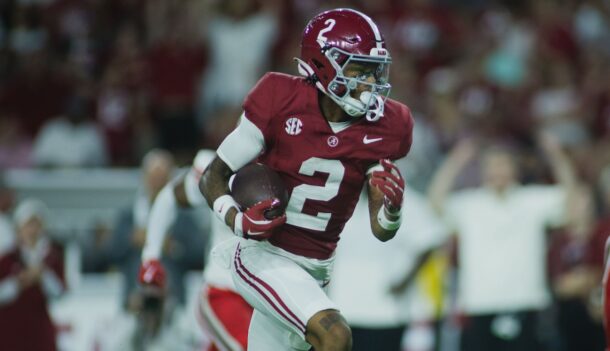Behind the scenes of ESPN’s ‘Gruden’s QB Camp,’ Tennessee’s Joshua Dobbs put under microscope
By John Crist
Published:
KISSIMMEE, Fla. — Joshua Dobbs is at the white board diagramming a play for Jon Gruden. No, it’s not everyone’s favorite: Spider 2 Y Banana.
Instead, Dobbs sketches Right Star 98 Curb. It’s a three-man bunch formation and results in what is essentially a corner route from one receiver and a rub route from the other two, which is effective in the red zone and in short-yardage situations.
Before Dobbs even grabs a marker, Gruden had queued up several examples on video — he has a black belt when it comes to operating his clicker — of Dobbs running that exact play. The closer his offense got to paydirt, the more likely he was to make that call at the line of scrimmage. 98 Curb was clearly a staple of the system.
“We need to change that call,” says Tennessee coach Butch Jones, who is sitting next to me in the green room watching the discussion on a big-screen television.
But Dobbs didn’t come to Gruden to wax poetic about his college career. He’s here to better prepare himself for the NFL.
Needless to say, the defensive schemes employed on Sunday are immeasurably more sophisticated than what Dobbs has faced on Saturday. Gruden points out that cornerbacks and safeties will eventually have an answer for 98 Curb.
According to Gruden, the two defensive backs in the pros will eliminate both the corner and the rub by playing an inside-outside technique — the safety takes the in-breaking route, while the cornerback gets the out-breaking route. What does Dobbs do then? He can’t just keep going back to the same old well at the next level.
Dobbs suggests calling for a “swap.” While maintaining the same concept, the route responsibilities for each wideout would change.
“Bingo,” Jones says, beaming with pride.
When 98 Curb becomes 98 Curb Swap, one of the receivers previously running the rub will now run the corner. The receiver previously running the corner will now be part of the rub. It’s the same play but run differently, which can confuse DBs.
Gruden likes what he hears from Dobbs. When he was coach of the Oakland Raiders, he ran similar concepts for the pair of Hall of Fame wideouts he had on his roster — Jerry Rice and Tim Brown — since bunch formations helped them get free releases. Canton-worthy pass catchers are even more effective when they’re not getting bumped.
While letting the cat out of the bag for 98 Curb was one thing, now Dobbs has alerted future ESPN viewers to 98 Curb Swap.
“We’re gonna have to change that, too,” Jones says, shaking his head.
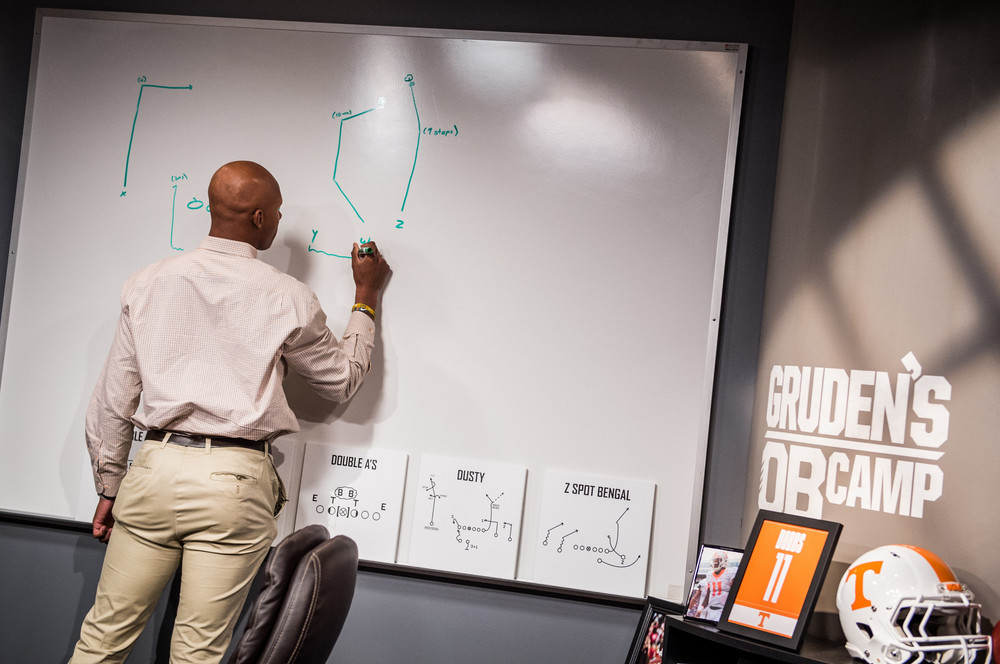
* * *
If you haven’t figured it out by now, we’re on the set of “Gruden’s QB Camp” at the ESPN Wide World of Sports complex just outside Orlando.
Now in its eighth season, the show has become a fan favorite and presents an up-close-and-personal look at the top quarterbacks available each year in the NFL Draft. A total of 50 QBs received the full Gruden treatment in Seasons 1-7.
Dobbs is one of seven to get the call for Season 8 — according to the draft experts at CBS Sports, he has the lowest grade of the lot. The others are Miami’s Brad Kaaya, Notre Dame’s DeShone Kizer, Texas Tech’s Patrick Mahomes, Pittsburgh’s Nathan Peterman, North Carolina’s Mitchell Trubisky and Clemson’s Deshaun Watson.
The Dobbs episode will air at 6:30 p.m. EDT Sunday on ESPN2. The half-hour program is split into two parts: a lesson in the film room inside followed by a workout on the practice field outside.
The film room is much smaller in person than it seems to be on television. In the middle is a big table, where Gruden is on the viewer’s left and the signal caller of the day sits across from him. Various pigskin paraphernalia adorns every wall.
The infamous Chucky doll is on display — Gruden’s cartoonish facial expressions make him a dubious doppelgänger for the animated star of the “Child’s Play” franchise — alongside photos, game balls and helmets. There are rows upon rows and stacks upon stacks of what appears to be game film, but they’re just empty boxes. Props, nothing more.
Before he won a Super Bowl as coach of the Tampa Bay Buccaneers, Gruden got his start as a graduate assistant at Tennessee in 1986.
As a result, he still feels some connection to the Volunteers program and has spent a good amount of time around Dobbs. When they went to the Outback Bowl two seasons ago in Gruden’s native Tampa, he was on the sideline in a UT polo.
Dobbs arrives in an orange button-up — sporting a Vols logo, of course — and khaki pants while carrying a brown portfolio. He gives the impression of being there for a job interview, and in a way he is. Gruden compliments him on his shirt while Dobbs autographs a football, which probably is customary for each and every field general.
While Gruden is the color man for “Monday Night Football,” this show is how he goes about scratching his itch to continue coaching.
“We’re gonna replay your whole career,” he says to Dobbs somewhat cryptically, just like Chucky might have to his next victim.
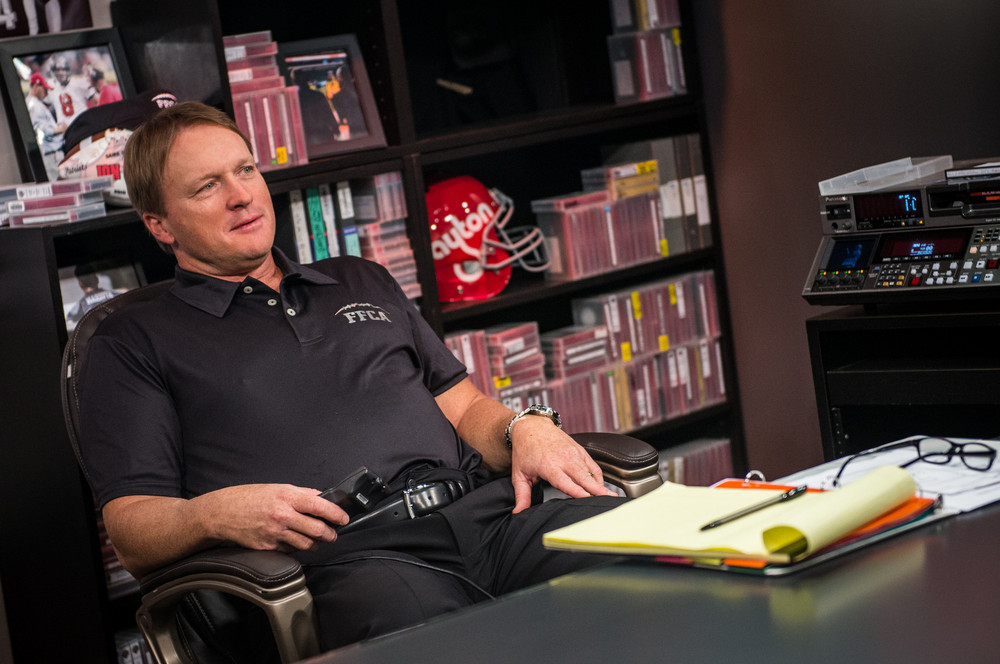
* * *
“Gruden’s QB Camp” is surely subjected to layer after layer of post-production, but the shooting in the film room is remarkably unrehearsed. Gruden offers little more than “how does my hair look?” to his crew before cameras begin rolling.
Even if only 22 minutes or so of actual footage avoids the cutting-room floor, Gruden grills Dobbs on every aspect of playing the game’s most important position for two-and-a-half hours — and that’s just the first session. Following a bathroom break, they’re back it for yet another two hours of study.
At no point does Gruden come up for air. On the screen, he seamlessly flips back and forth between Dobbs’ highlights and lowlights.
“Is this too deep for you?” he kiddingly asks, in the middle of explaining when Dobbs should audible from one running play (97 Wanda) to another (96 Slant).
There are a handful of common themes that repeatedly come up, though. “Can this guy throw?” is one question Gruden asks on a few occasions, not necessarily looking for an answer. But he wants Dobbs to hear it anyway.
The inevitable comparison Dobbs gets to Dak Prescott is mentioned by Gruden liberally. Like Dobbs, Prescott was a dual-threat quarterback who had a ton of success in the SEC — at Mississippi State, which doesn’t carry nearly the same weight in the conference as Tennessee — before surprising as a rookie for the Dallas Cowboys in 2016.
Also like Dobbs, Prescott had more doubters than believers during the pre-draft evaluation process and wasn’t selected until Round 4.
“Dak was here last year,” Gruden says, sternly. “Loved him.”
Gruden pulls up a graphic of the only QBs to throw for 50 touchdowns and run for 30 more in league history: Tim Tebow, Johnny Manziel, Prescott and Dobbs. It’s elite company, although Prescott is the only one to then succeed in the NFL.
One minute, Gruden is commending Dobbs for a comeback victory over Georgia — even that Hail Mary to beat the Bulldogs last year was a specific play call: Big Ben. The next, teacher is condemning pupil for an interception thrown against Appalachian State. Gruden masochistically shows the pick from seven angles. Dobbs squirms in his seat.
Whether it’s one of his standout plays or one of the real duds, Dobbs remembers every sequence with elephant-like precision.
“Pump fake,” he says, a mere second before the TV shows him, well, pump-faking in order to elude a Vanderbilt defender for a big gain on the ground.
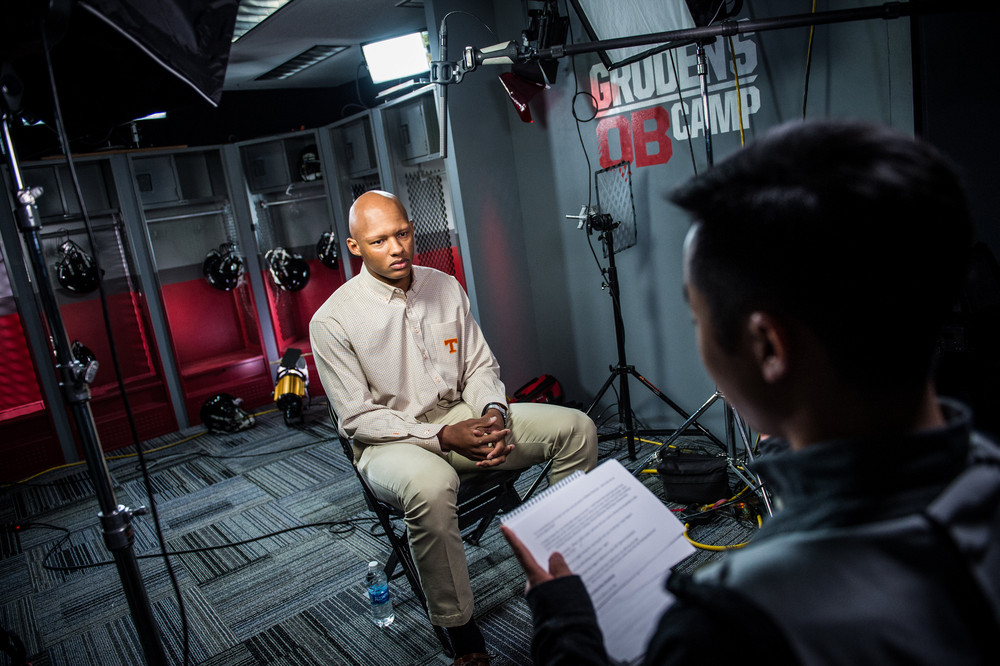
* * *
One thing that makes Dobbs unique is he’s studying Aerospace Engineering, as opposed to, say, Sport Management, which is typical of football players.
While his teammates were essentially taking classes on how to be an athlete, Dobbs was registered for the likes of AE 424 (Astronautics), AE 425 (Propulsion) and AE 426 (Introduction to Aerospace Design). In the same semester, no less.
Unlike a lot of prospects available in the draft — the vast majority, most likely — Dobbs has options beyond the gridiron. He already has an internship at aerospace manufacturer Pratt & Whitney on his résumé. The dictionary definition of a student-athlete, it’s tough to find anyone at Tennessee who got more out of a scholarship.
Of course, because the NFL takes itself way too seriously, some decision makers will view Dobbs’ advanced education as a negative.
“Why don’t you just quit football and build airplanes?” Gruden asks, perhaps genuinely curious.
Most folks remember “Pi” from school. It’s the ratio of a circle’s circumference to its diameter. While it’s commonly shortened to 3.14, Pi is an irrational number. Its digits beyond the decimal point go to infinity.
On National Pi Day — it occurs every year on March 14 (3/14), naturally — Dobbs recited the first 74 digits of the mathematical constant off the top of his head. There’s video evidence of this, by the way. As a matter of fact, Gruden included said video in his film study. It’s gotten over 12,000 views on YouTube.
Color Gruden less than impressed, though. Football coaches tend to believe that nothing can be more complicated than Spider 2 Y Banana.
“Ask me a question,” Gruden says, challenging him a bit. “It can’t be that hard.”
Dobbs proceeds to rattle off something from his Airplane Performance class. Quite honestly, it went over my head completely. I had every intention of summarizing it in my notebook, but that page has a not-so-mysterious blank spot.
If Dobbs were to ever make his home in Seattle, the odds are better that he’s working for Boeing — the aerospace and defense company is headquartered there — than quarterbacking the Seahawks. Teams will wonder just how badly he wants to play in the pros. Is football a job and flying a hobby, or is it the other way around?
Time and again, Dobbs reiterates that he loves the game. Engineering will always be there. The NFL won’t. But Gruden continues to poke and prod.
“Why are you even here?” he wonders aloud.

* * *
Nothing Gruden shows Dobbs on tape is there by accident, including the catches being made by then-Cleveland Browns receiver Terrelle Pryor.
Pryor, a quarterback at Ohio State from 2008-10, spent almost half a decade bouncing around the league as a backup QB. The Oakland Raiders, Seattle Seahawks, Kansas City Chiefs and Cincinnati Bengals all gave up on him.
But upon switching positions to wideout for the 2015 campaign, Pryor unexpectedly made the 53-man roster in Cleveland. While he only caught a single pass that year — granted, it was a 42-yarder — the stage was set for a breakout 2016. He recorded a stunning 77 receptions for 1,007 yards and 4 touchdowns for the Browns.
Last month, Pryor signed a 1-year, $8 million contract with the Washington Redskins. Still, Dobbs wants to throw passes, not catch them.
“What if I ask you to move positions, play wideout?” Gruden asks, again needling his subject.
“I’m trying to play quarterback,” Dobbs says, and quickly.
Throughout taping, Gruden references on more than one occasion how wowed he is that Dobbs was able to run for 2,160 yards during his career in the SEC. Front-seven defenders are bigger, faster and stronger in that conference.
Pryor is listed at 6-foot-4 and 223 pounds, while Dobbs has a similar build at 6-3 and 216. Like Pryor, Dobbs will enter the pros with most everyone questioning if he’s a good enough passer — even Gruden questions it — to play that position at this level. Dobbs isn’t as explosive of an athlete as Pryor, but he does have 4.6 speed.
While Dobbs is too polite to get cross with Gruden, it’s not hard to tell that he wants to move on from all this Pryor talk.
“I’m gonna be the dude throwing the ball to him,” Dobbs says, his tone a bit more direct.
It’s not like Dobbs was a liability in the aerial attack for Tennessee. He had the No. 1 passer efficiency rating in the league (150.6) last season. Nationally, he ranked higher than Kaaya (150.3) and Kizer (145.6).
Nevertheless, he’s the furthest thing from prototypical. His frame is a bit on the wiry side. His arm strength is average, as is his ball placement. He turned the ball over too often as a senior — 12 INTs thrown, 4 fumbles lost — and his decision-making sometimes left the Neyland Stadium faithful scratching their heads.
Prescott wasn’t considered an elite prospect either, although nobody suggested it was time for him to move to H-back.
“What do you think?” Gruden asks one last time. “Do you want to run some routes today?”
“I’m good,” Dobbs says, not even looking up.

* * *
The green room across from where filming takes place is cozy, which is another way of saying it’s also incredibly small.
Sitting to my right is Emily Proud, a television reporter from WATE in Knoxville. We are the only media on hand for the taping. As referenced before, Jones is sitting to my left. He happens to be in town for the Arnold Palmer Invitational.
Not only is Dobbs taking notes, but so is Jones. He isn’t here just to spectate and offer support. He’s here to learn something, as well. Despite the fact that Gruden hasn’t coached since the 2008 season — he was never able to recreate that initial magic with the Bucs — he’s still universally respected as an offensive mind.
In the middle of the film session, Dobbs’ phone blows up. He apologizes to Gruden and slides it back into his pocket.
“His mom will probably text him about a hundred times,” Jones leans in to tell me.
As it turns out, it wasn’t his mother. It was Los Angeles Chargers coach Anthony Lynn. Philip Rivers will turn 36 this coming season, so the organization is probably hunting for a young quarterback to groom for the future.
Gruden begins to show tape of Dobbs making his debut in a Tennessee uniform. Plagued by injuries and ineffectiveness in 2013, Jones pulled the redshirt off Dobbs and threw him to the proverbial wolves — an eventual 45-10 drubbing at the hands of defending national champion Alabama. On the road in late October, no less.
Dobbs won his final start as a freshman, 27-14 over Kentucky. However, when 2014 opened, he wasn’t atop the depth chart. Justin Worley was.
“He wouldn’t be here today if we hadn’t done that,” Jones says, again leaning in as if to tell me and me alone.
To be clear, it’s not like Jones intentionally went with Worley, who started the first seven games before a 3-interception disaster at Ole Miss unceremoniously ended his Volunteers tenure, for the specific purpose of motivating Dobbs.
But it’s fair for Jones to suggest that Dobbs became a better player for it. Dobbs was a part of Jones’ primary recruiting class at UT — a six-hour in-home visit flipped the 4-star prospect from Arizona State — so the two have grown together: Jones as the coach at a premier program, Dobbs as a star in the best conference in America.
Finally, Jones gets to see Dobbs at the break. They exchange pleasantries, albeit only for a moment on what is a busy day.
“Sorry I gave all the plays away,” Dobbs tells Jones with a chuckle.

* * *
There’s more to the film session than Gruden simply showing Dobbs what he did and didn’t do well at the collegiate level.
Gruden is installing a mini offense that will be run later on the practice field. Remember 98 Curb? That’s one of the plays Dobbs is responsible for once he slips off his loafers and laces up a pair of cleats.
So are the two aforementioned running plays, 97 Wanda and 96 Slant. Based on what the defense is showing — Wanda targets the weak side, while Slant attacks the strong side — Dobbs will run the play as called or check to the other. “Recognize. Communicate. Execute.” That’s the three-tiered maxim Gruden wants Dobbs to master on the fly.
In addition to Curb, a handful of other route concepts like Chase and Hank will be employed out of bunch formations.
“Is this meeting too long?” Gruden comically asks.
“Never,” Dobbs instantly responds.
According to Gruden, Dobbs will be facing a defensive call a lot in the NFL known as 1 Plug. It’s basically Cover 1, meaning a single-high safety in the middle of the field responsible for anything deep, plus man coverage underneath.
The “plugger” is a linebacker operating as a spy in order to help neutralize Dobbs’ running. As Gruden explains it, a classic pocket passer like Tom Brady isn’t going to see 1 Plug. That’s one fewer defender — the New England Patriots have answers for any coverage, be it man or zone — to either drop or rush.
There are also various defensive fronts that Dobbs has to recognize, from King to Queen and Green to Bronco.
“What are you laughing at?” Gruden asks with a grin. Dobbs can’t stop himself from smiling. Gruden is unintentionally funny when throwing out terminology.
What will be this episode’s memorable catchphrase, the Spider 2 Y Banana? It will probably be the Bison Blitz. Early in the first session, Gruden ordered up the Oklahoma game from 2015. Tennessee led 17-3 at halftime but lost 31-24.
Repeatedly, the Sooners confused Dobbs with the Bison — a double blitz from a linebacker and the strong safety, as the free safety and both cornerbacks roll late into Cover 3 — and forced a handful of horrid decisions from him. Clip after clip, it was evident to Gruden that the Bison completely changed the outcome of that contest.
So how can Dobbs beat the Bison Blitz? By audibling to 97 Wanda, of course. Weak-side runs tend to shred strong-side blitzes.
“Now it’s time for some above-the-neck training,” Gruden says, wrapping up the day’s film work.
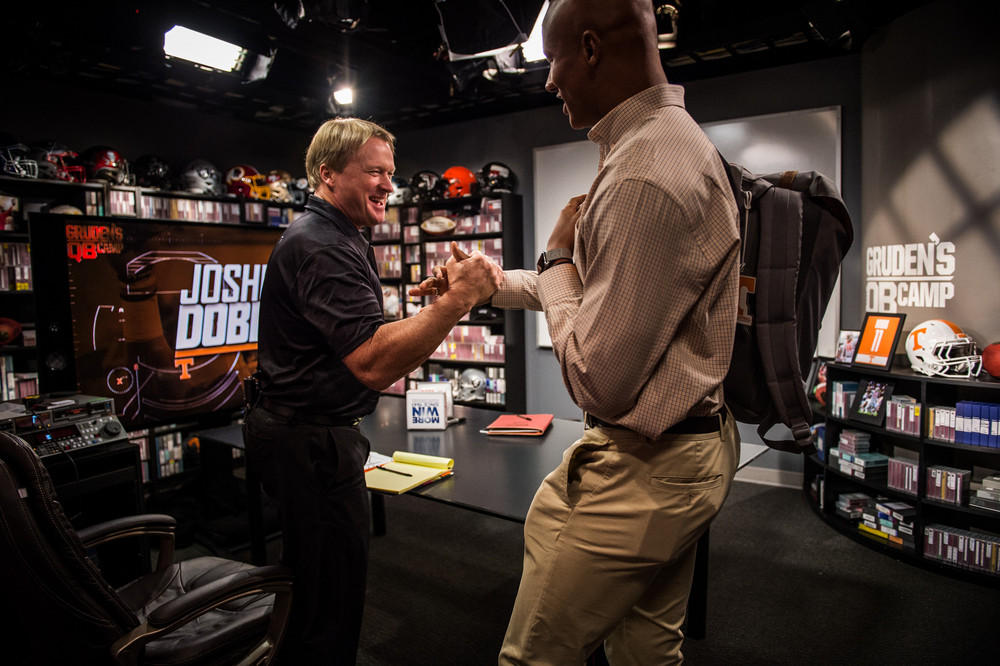
* * *
With the back-to-back study sessions now complete, Dobbs leaves the film room for a bite to eat and to change into his workout gear.
He walks past the Chucky doll. Past the game ball Gruden was given as receivers coach of the Green Bay Packers after a win over the Chicago Bears. Past the helmet from Dayton, where he was primarily a backup quarterback for three seasons.
Dobbs walks past a wall of framed photos, as well. These are some of the “Gruden’s QB Camp” alumni, including a few of the elite QBs in today’s NFL. Derek Carr. Andrew Luck. Cam Newton. Russell Wilson. Jameis Winston. Prescott’s image is hanging, too. Not all of them are success stories, though — a shot of Tebow, for example, remains.
With Dobbs now out of the room and Gruden just shooting the breeze with his staffers, no poker face is necessary.
“I love him,” Gruden says, to nobody in particular. “He’s going to be a steal.”
In a black No. 11 jersey, black shorts, black hat, white sleeves, white leggings and orange cleats, Dobbs starts getting loose. He’ll be throwing to the likes of receiver Kenny Shaw and running back Bobby Rainey, who both had a cup of coffee in the league.
Even as Dobbs is warming up, Gruden is never far from sight. His inner coach is also warming up — “Start fast today, Dobbs. Stay in the pocket, Dobbs.” — as he morphs from lovable TV personality back into fiery sideline sergeant. Football legislation keeps restricting on-the-field time, so he wants practices run at a blistering pace.
With everybody now ready to go, from Dobbs to Gruden to the various offensive and defensive players participating, Gruden calls the first play.
“Let’s hear it for Josh Dobbs out of Tennessee!” he announces enthusiastically, which draws a round of applause for the cameras.
Every component of the quickie offense Gruden installed in the film room is now live. Dobbs kills 97 Wanda in favor of 96 Slant. He throws 98 Curb a bunch. Florida linebacker Jarrad Davis happens to be the “plugger” in the middle of 1 Plug.
The performance itself isn’t overly important — I was the only one scribbling notes from start to finish — but Dobbs does some good things and some bad things. He airmails his first throw on 72 Special, which features every receiver running a vertical route, although he comes back and hits the next two on the same call.
Indianapolis Colts cornerback Charles James, who works out in Orlando during the offseason, likes what he sees from Dobbs.
“He can make all the throws,” James tells me. “He just needs to go to a good team with a good system and good players. That’s half the battle sometimes. If you don’t have that …”
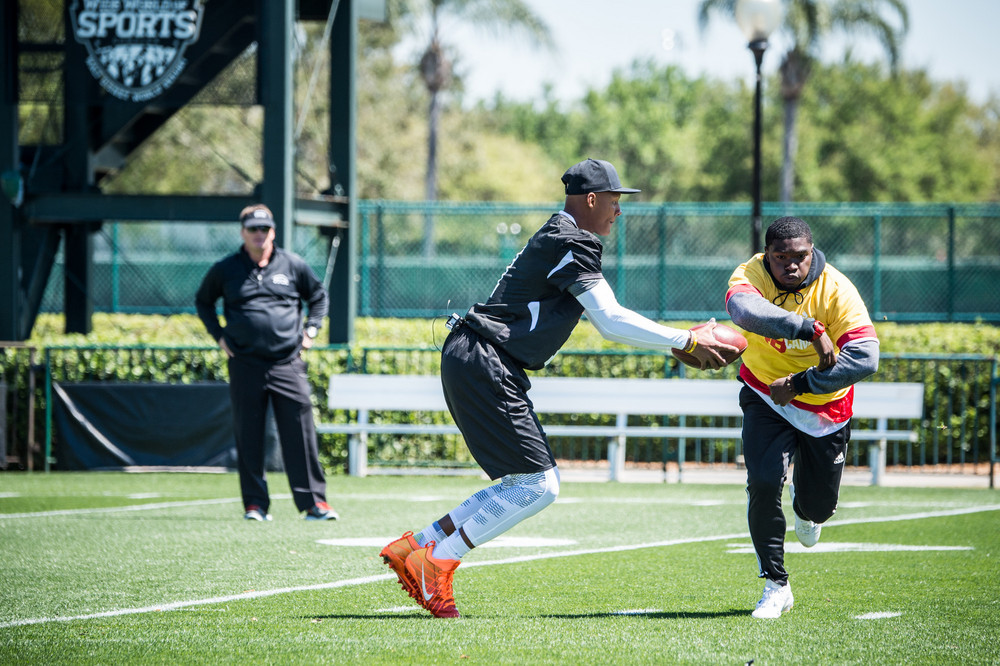
* * *
Once filming is complete, Dobbs heads to the far side of the field to shoot some B-roll footage with a camera crew.
On the walk back, he is greeted by Jones and a few administrative members of the Tennessee program. Even if the Volunteers failed to win anything significant with Dobbs at the controls, he’s going to be awfully difficult to replace.
Eventually, he makes his way over to me. Having spent a decent amount of time with him in January at the Senior Bowl — it produced a much different kind of feature story, to be honest — Dobbs recognizes my face. Just like he did in Mobile, he greets me with a warm smile, a firm handshake and a confident voice.
Where did he feel like he really stood out today? Drawing up plays on the white board, or executing plays against live bodies?
“I think I excelled in both,” Dobbs tells me. “It was fun. You go in the film room there for four-and-a-half hours, just talking ball with Coach Gruden. Just talking everything, about NFL tape, pressures, different situations, watching your film, highlights, lowlights throughout your career, so it was a lot of fun.
“I had a productive day. I was able to come out and throw well to the receivers and come out and execute the quick offense I would have installed on the field, so I felt like it was an all-encompassing day. I learned a lot and also performed well.”
While the language of football isn’t exactly universal, a lot of the vocabulary translates easily from system to system. Like if you took some Spanish in high school, chances are you comprehend a little Italian. It’s rarely Spanish to Chinese.
“It comes naturally, especially once coach sits down and draws it out or explains what they are doing,” Dobbs says. “If you’ve been around the game, you understand that at the end of the day, just about every team runs the same plays. Just everyone calls it something different.
“And it’s about players, not plays, and it’s about making the use of plays. That’s what it comes down to, and that’s what differentiates teams and different coaches’ philosophies. It’s cool to be around a great offensive mind, pick his brain and talk to him. It was a fun day.”
Back in the film room, there were instances when Gruden started a sentence and Dobbs finished it. On the other hand, every now and then the teacher dialed up vernacular — how they signaled protections, for one, was vastly different — that put a puzzled look on the pupil’s face. But overall, they were on the same page.
“He started to draw up Stick Lookie, and it’s a big concept that we ran out of the backfield and empty,” Dobbs says. “You have the stick on one side and then the back option on the other, so it’s a raw concept that we ran at the Senior Bowl, as well. And we called it the same terminology.
“It just goes to show that the offense we have been able to run and learn and run at a high level in college will be the same kind offense that I’m running at the next level. We’ll be able to do different things, keep some of the calls, mix in some different run-game stuff with pro-style pass concepts, and that’s why we were successful. And that’s why the team will grow to the next level.”
No matter how the final product turns out on TV, Gruden didn’t throw Dobbs a series of softballs. He got after him more than once.
“Honestly, nothing really stumped me,” Dobbs says. “It was just something that he might have called something differently, and you were like, ‘Oh, that’s what you call it. This is what I call it.’ Stuff like that, but nothing really stumped me.”
In the end, this is a television show. It’s more entertainment than workout. Still, he took it seriously. No question about it, NFL franchises thinking about taking Dobbs on draft weekend will consider this part of his evaluation.
“Any time you have a platform like this, with any type of media outlet, it’s a job interview,” he says. “Teams are watching your every move, trying to see what quarterback can they trust to be the face of their organization. Platforms like this, of course, it’s definitely in your draft grade.
“You’re being quizzed like this by the wizard himself in the film room. You’re coming out and quickly install offense and trying to look good doing it, as well. And then you’re in the spotlight, where he’s looking to see all your adversity that you’ve been through and how you respond to those and what your mindset is and what type of leader you are and what type of person you are in the end. So any time you’re able to have a platform like this, or any platform, then it definitely goes into your grade and it’s definitely a part of the all-encompassing job interview.”

* * *
Even though he’s been in the “Monday Night Football” booth since 2009, Gruden is still finding his way as a broadcaster.
When a big coaching job opens up, be it in the NFL (Los Angeles Rams) or college (Notre Dame), his name is unavoidably a part of the rumor mill. Coincidentally, he could have had the Tennessee gig before it was given to Jones.
If there’s a complaint about Gruden on TV — it’s minor, as overall his analysis is appreciated — it’s that he’s too generous with praise. From All-Pro quarterbacks to anonymous gunners on special teams, compliments are handed out like candy on Halloween. For hardcore viewers, he’s not critical of players or coaches often enough.
Of the 50-some QBs to appear on his show, he’s never run one out of the room. To the surprise of no one, Gruden is a fan of Dobbs.
“He’s one of the most productive quarterbacks in SEC history,” Gruden tells me. “His running ability is unbelievable. He ran for 2,200 yards in the Southeastern Conference. His durability and toughness and effort really stands out. I think he helped bring Tennessee back. I mean, that’s what really impresses me.
“That was not a very good team at all, and he went there and they peeled the redshirt off him and he hung in there and took ’em to a bowl game his second year, so I like that. I just want to discover how much he’s improved. Same thing with Dak Prescott last year. I know he can run. I know he can throw the RPOs. But can he stand in the pocket and get it done consistently?”
The Prescott comps might help Dobbs. Both were spread-option passers from the SEC, ran the ball as well as they threw it and had zero red flags off the field. Prescott was an outlier, though. Dobbs is unlikely to pay similar dividends immediately.
“There’s a lot of people who are gonna write stories and a lot of us analysts are gonna analyze it, but it all depends on where he goes,” Gruden says. “It all depended on where Dak went. You know, Dak hit the lottery. He went to a really good team, and two guys ahead of him got hurt. And I’m not saying that’s a good thing that guys got hurt, but I’m just saying things worked out.
“Hopefully, he gets on a team that knows how to use him, he gets a supporting cast that can help him and he gets some continuity where he can learn in the system. I think that’s gonna be what’s important.”
More often than not, coaches control the college game. You see it every Saturday in the fall. After the offense quickly gets to the line of scrimmage — is anyone not running some version of a hurry-up scheme these days? — each player looks to the sideline for the call. But in the pros, more responsibility is placed on the man pulling the trigger.
“It’s a language barrier, I think,” Gruden says. “The terminology is never gonna be the same. Year in and year out your terminology changes, even if you’re the same coach on the same team. You change. You tweak your terminology every year. That’ll be a challenge for him.
“The big challenge for all these young quarterbacks is getting in a huddle, handling multiple formations, different personnel groupings, and then going to the line of scrimmage on your own and recognizing the defense and then deciding what is best for your team. Because a lot of this stuff comes from the sideline, as you know.”
Dobbs wasn’t always a pre-snap decision maker. Those goofy posters with images of Beyoncé and The Flash usually told everyone what to do.
While intelligence is a factor, it takes more than brains to dissect a defense. EJ Manuel, who I covered at Florida State, was very bright and took graduate-level criminology courses. But in the pocket, he didn’t process information quickly.
Conversely, the above-mentioned Winston took over for the Seminoles after Manuel was a first-round choice of the Buffalo Bills — a busted one, predictably — and had a better grasp of coach Jimbo Fisher’s offense as a redshirt freshman than Manuel did as a fifth-year senior. Does Dobbs see the game like Manuel or Winston?
“I’ve known Dobbs a long time,” Gruden says. “I mean, I’ve been close to the Tennessee program. I’ve seen him since he was a pup. There’s no doubt in my mind he can play, and I just think he’s gonna have to get in a good situation. I think he’s a wild card. Initially, I think he can be used in a lot of creative situations, but I think he’s really improved as a passer.
“I know with his work ethic and his effort, he’s gonna continue to do that.”

* * *
After Gruden was let go by Tampa Bay, he started the Fired Football Coaches Association. The organization is dedicated to giving back to the game, specifically at the prep level.
Before the cameras roll, Dobbs hands him an envelope. Inside is a donation check — paid for out of his own money — to show his appreciation for Gruden’s charitable side. “That’s a Gruden first,” he says, clearly blown away by the gesture.
Later, Gruden announces that the FFCA is giving $5,000 to Alpharetta High School in suburban Atlanta, which is Dobbs’ alma mater.
John Crist is the senior writer for Saturday Down South, a member of the FWAA and a voter for the Heisman Trophy. Send him an e-mail, like him on Facebook or follow him on Twitter.
John Crist is an award-winning contributor to Saturday Down South.



